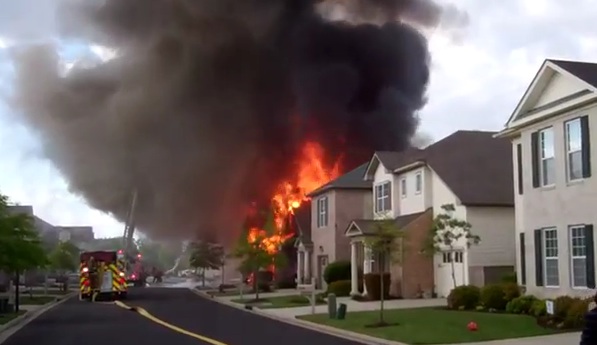Fire Marshal says truck blaze provides good example of how house fires can spread. Illustrates issues with vinyl siding.

 Loudoun County, Virginia’s Chief Fire Marshal Keith Brower says this picture from taken by his office tells the story of what many in the fire service see as problems with vinyl siding.
Loudoun County, Virginia’s Chief Fire Marshal Keith Brower says this picture from taken by his office tells the story of what many in the fire service see as problems with vinyl siding.
A fire on Tuesday destroyed a truck parked in the driveway of a home in Loudoun County’s Broadlands community. Loudoun County Chief Fire Marshal Keith Brower says the fire was a good example of how the material used in building homes can inhibit or encourage fire spread.
The truck was being used by a gutter installation company on an almost completed home at 21975 Auction Barn Way. Brower says the fire started in a generator of the truck and and soon engulfed the vehicle in flames. Despite the burning truck’s proximity to the home, the house suffered only minor damage with some discoloration to the siding.
But a home about three times the distance away lost a whole wall of siding. That siding melted. The difference says Brower is that the melted siding is vinyl.
Vinyl siding meets the building code and is used around the world. Brower and others in the fire service have long cited vinyl siding as a contributing factor in fires spreading from one home to the next.
STATter 911 attempted to contact the Vinyl Siding Institute in Washington, but has not received a response. In the past the trade organization has defended use of the material.
On its website, under the heading Siding With Safety, the Vinyl Siding Institute provides this safety information about fires:
Safe homes use fire-safe claddings, which include vinyl siding. Why does vinyl siding provide good fire performance? It is composed mainly of polyvinyl chloride, more commonly known as vinyl or PVC. Due to its chlorine base, vinyl siding does not ignite quickly and is inherently flame-retardant.
All organic materials (that is, anything containing carbon) will ignite. But the higher the temperature a material has to reach before it flames, the safer it is.
PVC won’t ignite, even from another flame, until it reaches about 730°F (387°C) and won’t self-ignite until about 850°F (454°C). Those ignition temperatures are significantly higher than common framing lumber, which ignites from a flame at 500°F (260°C) and self-ignites at 770°F (410°C).
The website points to this information from the NFPA:
Most home structure fires originate in the interior of the home. Only 4 in 100 house fires start on the outside of the structure and fewer than 2 of 100 house fires originate with the exterior wall surface.
Brower says the house closest to the fire was finished with Hardy Board. Hardy Board is a composite material of wood and masonry fiber.
Chief Brower believes if the house closest to the burning truck had vinyl siding instead of Hardy Board, the fire would have likely spread to the home. Brower says the resulting fire would have provided much more radiant heat that could have also ignited the neighboring home.
More pictures below from the Loudoun County Department of Fire, Rescue and Emergency Management.





